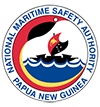PNG’s Particularly Sensitive Sea Area (PSSA) - Papua New Guinea National Maritime Safety Authority
Papua New Guinea obtained its first ever Particularly Sensitive Sea Area (PSSA) designation from the IMO in its MEPC 70 th Meeting in 2016 in the region surrounding the Jomard Entrance, part of the Louisiade Archipelago at the south eastern extent of the Milne Bay Province. (see Figure 1 below). The PSSA is centred on the Jomard Islands, and includes Bramble Haven to the north-west. The region falls within Zone 1 of the Milne Bay Seascape, which has been accepted as meeting all the requirements for the UNESCO World Heritage Tentative lists as a mixed property. The Government of PNG continues to work towards nomination of the Milne Bay Seascape for inscription on the World Heritage List.
The objective of the designated PSSA is to protect the area’s unique and threatened species as well as to preserve as far as practicable its critical habitat and diversity, while allowing for projected increased shipping traffic using the Jomard Entrance. The PSSA designation includes newly established routeing systems (four two-way routes and a precautionary area), adopted at MSC 94, as the Associated Protective Measures.
A risk assessment has indicated that these APMs could reduce the frequency of collisions by 50%. The APMs also reduce the risk of physical damage to sensitive reef areas and marine pollution caused by groundings. In addition to addressing the increasing risk through the implementation of the APMs, PSSA designation is considered necessary to increase community and mariner’s awareness of the area’s sensitivity and associated risks of navigation.

A list of geographical coordinates of the designated Particularly Sensitive Sea Area is provided below. All geographical positions are based on WGS 84.
| No. | Latitude | Longitude |
| 1 | 11°10.00’S | 151°53.00’E |
| 2 | 11°26.00’S | 151°59.90’E |
| 3 | 11°26.00’S | 152°08.24’E |
| 4 | 11°23.00’S | 152°13.00’E |
| 5 | 11°10.00’S | 152°13.00’E |
Shipping traffic in Jomard Entrance has limited sea room. This means, given the volume of shipping, ship encounters tend to be head on (or, in some cases, following). The Two-way routes and associated precautionary area have made navigation safer, easier and more predictive by reducing the risk of collisions, physical damage and marine pollution. They also better accommodate the large increase in traffic that is anticipated in the coming years due to strong growth in commodity exports (mainly coal and LNG) from ports in the region and the growth of marine tourism. The two-way routes as its APM aligns with the existing traffic flow as closely as possible and the well-defined and clearly charted routes allow for prudent navigation and discourages taking “short-cuts”. In summary, there has been little to no impact on the routes that ships would otherwise follow, and the designation of the area as a PSSA will not place any additional burden on international shipping. The Government of PNG would, however, wish to emphasize the important of full compliance with the MARPOL Convention by all ships using the Jomard Entrance.

